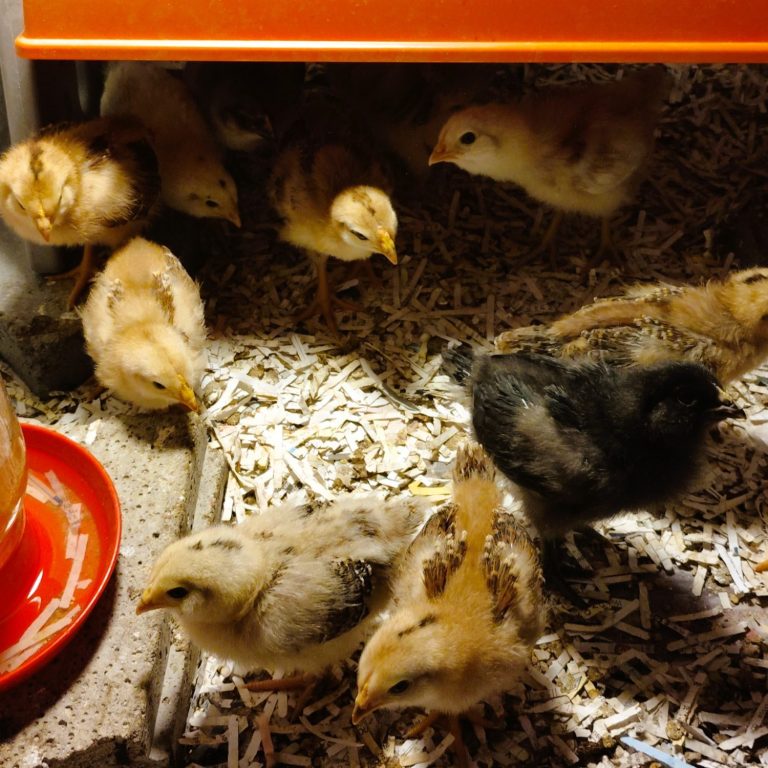
What do you need to raise chicks?
Before getting cute fluffy baby chicks for the first time there is a few things to consider.
Where will they live? A coop should provide 3 to 6 sq feet per chicken, with adequate air flow. We set up vents that can open and close depending on the weather. Roost bars should provide 10 to 12 inches per bird. Seems like a lot for these tiny little babies, but they are only small for a few weeks. Next they will need nest boxes. Five birds will be ok with 1 nest box, I would suggest 2, our 26 hens have 8 nest boxes and only use 5 of them. An outdoor run is also very nice, like everyone they enjoy fresh air and sunshine. They like shade also. Our coop does have electricity so we do have a light in it and we can use a heated waterer in the winter. Hens usually will not need a heat light but when the temp drops to 25 below 0, we do use one. Electricity is not necessary as long as the coop is an appropriate size for the number of hens, they will keep each other warm. You will need to be sure they can access water year round.
We try to provide roost bars in the outdoor run also because in nicer weather, many of our hens will sleep outside. The run is fully enclosed with 2x4 wire and chicken wire. There are some strips of old siding across the top to provide some shade. Also I find that during the nicer part of the year if I keep the water outside there are fewer mice inside. Also when possible feeding them outside helps prevent mice as well.
The next thing to consider is predators. Here we have coyotes, snakes, mice, raccoons, skunks and hawks. We did loose 1 flock to a raccoon family and several more hens to a skunk. For several years we lost a lot of hens to the coyotes. We have since added yard lights and surrounded the chicken yard with 2x4 wire and field wire around the remainder of the property. Adding 2 dogs to the crew has also been a game changer.
Ok all set for chickens. Next thing none of the above will work for baby chicks. At even 2 weeks old a chick can get through chicken wire and they still get cold. So unless you forgo the cute little fluff balls you will need a brooder. These can be a simple as a cardboard box or more complex like the set up we have. Most feed stores will have a starter kit with heat light, waterer, feeder and a cardboard ring. This setup on a dirt floor or a piece of Astro turf or outdoor type carpet on a cement floor will work for a week or 2, Once the little guys discover their wings they will fly over the top. Our first brooder was a 10 gallon fish tank with a screen top. Back then we were only keeping 6 hens. Now we raise 50 or more from hatch to egg layer as well as another 50 to 70 meat birds and turkeys. They all start out in this stock tank brooder. No not all at the same time. The stock tank comes into the living room in March and is there sometimes until mid July.
The babies will be in the brooder for 10 days to 3 weeks depending on the weather. They then move to the chick coop where there is a heat light for the cooler days and at night and at 2 weeks they are allowed out to the pen. The baby coop is a separate room in the hen house and has it's own pen. At about 8 weeks the young hens are transitioned to the hen house and the rooster to the chicken tractors.
Alternatively, a broody hen will hatch 3 to 10 chicks and raise then. Hens may get broody even with no rooster present. They do get very mean. I did have a mother hen that killed one of the younger hens, so if they want to be broody they will need to do so out in the yard and not in the coop. I currently have 2 broodies in the coop and 1 is really mean. I wear my leather gloves an long sleeve shirt to gather eggs. They will only be broody for about 3 to 4 weeks.
©Copyright. All rights reserved.
We need your consent to load the translations
We use a third-party service to translate the website content that may collect data about your activity. Please review the details in the privacy policy and accept the service to view the translations.


